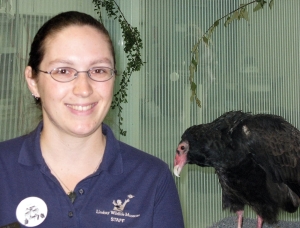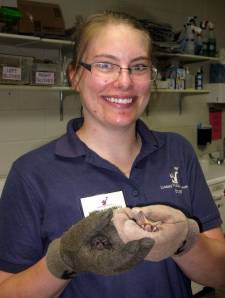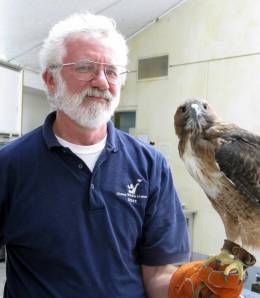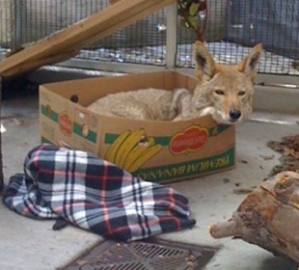by Dawn Manley, Animal Husbandry Manager
Lindsay Wildlife Museum is fortunate to have such diverse, talented and dedicated people working here. Many museum staff members started as a volunteer. For this article, I interviewed four part-time animal encounters staff members who began their Animal Encounters career as a volunteer.
Melissa Eitzel

Melissa with Diablo the turkey vulture
What is your volunteer experience at the museum and how long have you been on staff?
I was an Interpretive Guide in the ‘90s and returned to be a volunteer museum interpreter in late 2008. I’m now a part-time museum interpreter. I’ve been working here on Sundays since November 2009.
What do you do when you are not at the museum?
I’m a graduate student in Environmental Science, Policy and Management at UC Berkeley.
What do you like most about working in the AE department?
I love the interactions with our wildlife, our visitors and especially with my coworkers, volunteer and staff alike. The museum is a wonderful and positive place to work. I enjoy applying my love of explaining things to the worthy goal of sharing our local wildlife with fellow community members.
Summer Chrisman

Summer with the mexican free-tailed bat (L) and pallid bat (R)
What is your volunteer experience at the museum and how long have you been on staff?
I started as an Interpretive Guide in 2000 at 16 and graduated to the mammal team. After taking a break for college, I came back as an animal encounters husbandry intern for 6 months until I was hired. I’ve been a substitute keeper since April 2010. I typically work 1-2 days per week.
What do you do when you are not at the museum?
I have worked as a wildlife biological science technician for the Forest Service in South Lake Tahoe doing raptor surveys and as a wildlife biologist for the Wyoming Department of Fish and Game doing bat surveys. I am also an active Girl Scout volunteer camp counselor leading backpacking trips in the high Sierra during late summer.
What do you like most about working at the museum?
I most enjoy watching the animals interact with their environments and helping make the full-time staff’s jobs easier. I am glad I can be a part of bringing people closer to the wildlife in their backyards.
Brittany Wensky

Brittany on her day off.
What was your volunteer position in the AE department and when were you hired as a substitute keeper?
I started at the museum as an intern in the summer of 2005 after I graduated from college. I’ve been a substitute since 2006 and I currently work about two days a month.
What do you do when you are not at the museum?
I work for the US Geological Survey as a biological science technician. I recently finished a field season of nest searching for upland-nesting ducks. My next assignment will be avian influenza sampling of ducks in the Sacramento Valley and the Delta. After that, I’ll work on data and processing field-collected samples (primarily avian) in Fremont. I’m a member of Kiwanis Club of Dixon, through which I volunteer for the local community.
What do you like most about working in the AE department?
I love working with wildlife, and the museum gives me the opportunity to get to know individual animals and to learn a different skill set. I also really enjoy the fact that the work at the museum is so different from what I do Monday to Friday. The staff at the museum really makes it worthwhile, too!
Bill O’Brien

Bill with the female red-tailed hawk.
What is your volunteer experience at the museum and how long have you been a substitute keeper?
I’ve been a hospital volunteer since 1998. I spend most of my time there in the holding room, working with the raptors. I’ve been working as a substitute keeper since 2007.
What do you do when you are not at the museum?
I’ve been a freelance journalist since…well, for a long time. I started out as a volunteer reporter for KPFA in Berkeley, covering local politics and attending the 1984 Democratic National Convention in San Francisco. I worked for a long time with the East Bay Express and other magazines. I’ve also worked in the wine industry, selling the stuff, teaching winemaking and working as a cellar rat during the fall crush. I’ve also painted houses, fixed guitars, and, while I was in college, worked in a state mental hospital, which was good preparation for dealing with all sorts of people (and come to think of it, animals also).
What do you like most about working in the AE department?
It’s a real pleasure to have colleagues who enjoy their work and who are committed to doing the best possible job. We all want to be here and that makes a difference in the workday. That and having the opportunity to work with some really cool animals.











